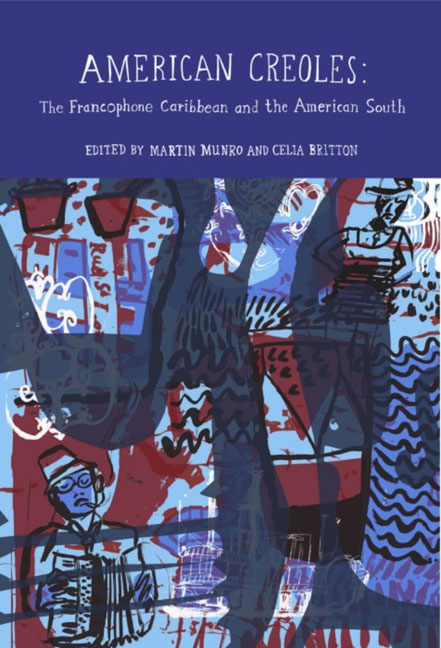Book contents
- Frontmatter
- Contents
- List of Illustrations
- Acknowledgements
- Introduction
- Creolizations
- Music
- ‘Fightin’ the Future': Rhythm and Creolization in the Circum-Caribbean
- Leaving the South: Frantz Fanon, Modern Jazz, and the Rejection of Négritude
- The Sorcerer and the Quimboiseur: Poetic Intention in the Works of Miles Davis and édouard Glissant
- Creolizing Jazz, Jazzing the Tout-monde: Jazz, Gwoka and the Poetics of Relation
- Intertextualities: Faulkner, Glissant, Condé
- Notes on Contributors
- Index
‘Fightin’ the Future': Rhythm and Creolization in the Circum-Caribbean
from Music
- Frontmatter
- Contents
- List of Illustrations
- Acknowledgements
- Introduction
- Creolizations
- Music
- ‘Fightin’ the Future': Rhythm and Creolization in the Circum-Caribbean
- Leaving the South: Frantz Fanon, Modern Jazz, and the Rejection of Négritude
- The Sorcerer and the Quimboiseur: Poetic Intention in the Works of Miles Davis and édouard Glissant
- Creolizing Jazz, Jazzing the Tout-monde: Jazz, Gwoka and the Poetics of Relation
- Intertextualities: Faulkner, Glissant, Condé
- Notes on Contributors
- Index
Summary
The plantation societies of the Americas were set up essentially as modern, profit-driven machines that used human beings as combustible, disposable parts. Far from nurturing cohesive communities, European colonists created anti-societies that relied on the continuous supply and consumption of bodies uprooted and thrown out of step, out of rhythm with the places and cultures they were born into. In the colonial Caribbean, where the indigenous population was more or less wiped out by illness and warfare, the new populations comprised many disparate groups of African slaves and a number of European nationalities. Set up to be dystopian, segregated work factories, these societies lacked the basic rhythmic socialization (a common, functional understanding of time, culture and work) that has been a fundamental element in bonding communities from the beginning of human history. And yet, among the enslaved people more organic and benign rhythms persisted and helped them survive the plantation and its anti-rhythmic foundations. Crucially, however, rhythm was not the property of one group, and it became one of the most effective means of transgressing social and racial divides, and in creating the unique social order and culture of the circum-Caribbean, the expanded regional space that includes the insular Caribbean and the countries linked to it by the sea and history. This chapter considers ways in which rhythm has functioned and continues to serve as a particularly malleable and persistent social and cultural element both in the Caribbean and in the American South, two sites that are connected historically through similarities in the physical and social configuration of the plantation and the societies that have emerged from it.
The initial focus on James Brown's rhythmic innovations in the 1960s identifies some of the salient aspects of his rhythms, and suggests some of the ways in which Brown ushered in an era in popular music in which rhythm has arguably become the predominant formal and stylistic element. Brown's rhythms were seized upon by Black Power militants and incorporated into a notion of black aesthetics that served a politicized idea of African-American culture as a largely homogeneous, untainted entity. At the same time, Brown himself was less inclined to consider his rhythms to be echoes of a recoverable racial past, and instead preferred to read them as pre-echoes of the future, and of sounds and ways of thinking that were yet to be realized.
- Type
- Chapter
- Information
- American CreolesThe Francophone Caribbean and the American South, pp. 113 - 128Publisher: Liverpool University PressPrint publication year: 2012



